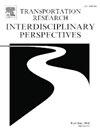A comprehensive assessment of arterial signal coordination through a case study
IF 3.9
Q2 TRANSPORTATION
Transportation Research Interdisciplinary Perspectives
Pub Date : 2025-01-01
DOI:10.1016/j.trip.2024.101321
引用次数: 0
Abstract
Many municipalities in developing countries still face the problem of choosing the most effective way to advance their traffic control systems based on isolated fixed-time traffic signals. The major alternatives are transitioning to adaptive traffic signals or coordinating existing isolated ones. To demonstrate the potential of coordination, the effectiveness of the coordinated timing plan for six local signalized intersections on the 1.8-kilometer-long segment of Nauky Ave. (arterial) in Kharkiv, Ukraine, has been thoroughly evaluated. For this purpose, the travel time along the coordinated segment was sampled. Also, the average travel time and vehicle speed on the minor street approaches to the coordinated intersections were calculated based on TomTom data. As a result, the coordinated timing plan clearly showed its high effectiveness. Considering the low implementation costs, this testifies that in cities where most traffic signals are isolated and fixed-time, the coordination may be much preferable to installing expensive adaptive signals. The obtained results confirm that coordination can serve as an effective traffic management measure to ensure sustainable traffic in municipalities with limited budgets. The main research benefit is obtaining a comprehensive practical assessment of the effectiveness of the implemented traffic control measures on a 1.8 km section of the arterial.
求助全文
约1分钟内获得全文
求助全文
来源期刊

Transportation Research Interdisciplinary Perspectives
Engineering-Automotive Engineering
CiteScore
12.90
自引率
0.00%
发文量
185
审稿时长
22 weeks
 求助内容:
求助内容: 应助结果提醒方式:
应助结果提醒方式:


